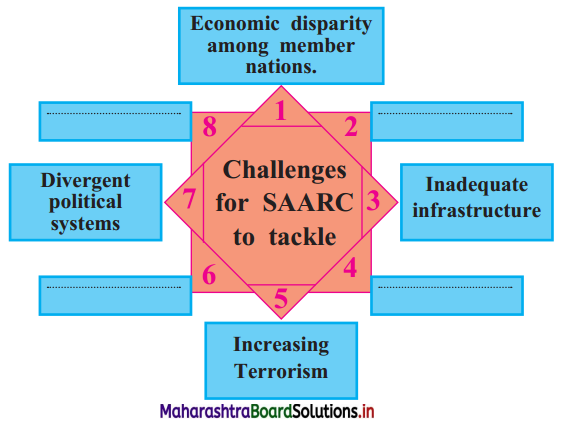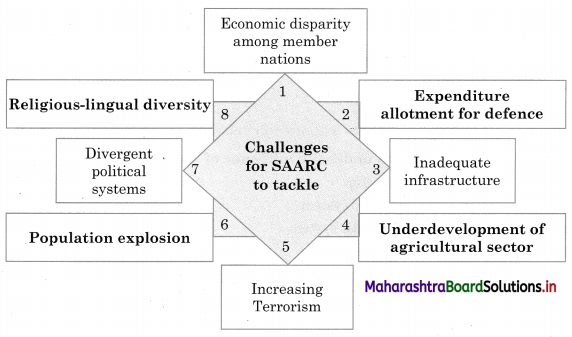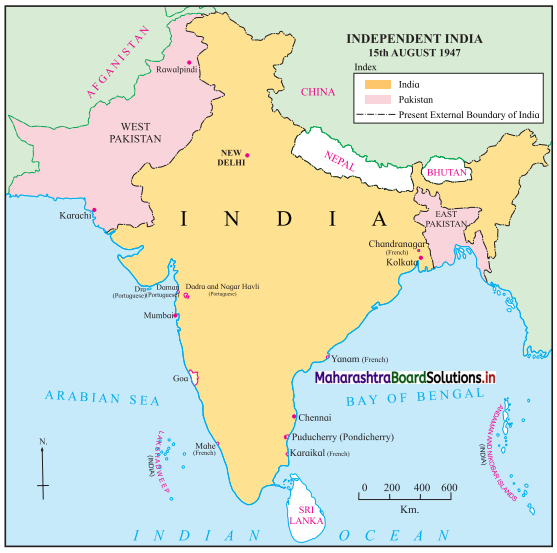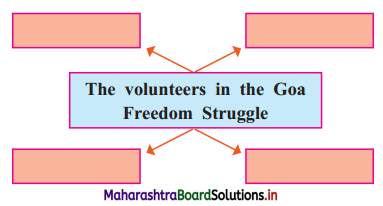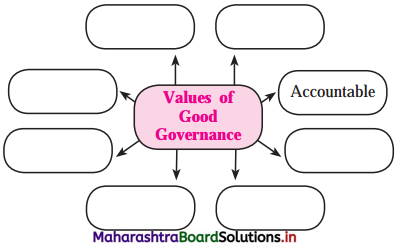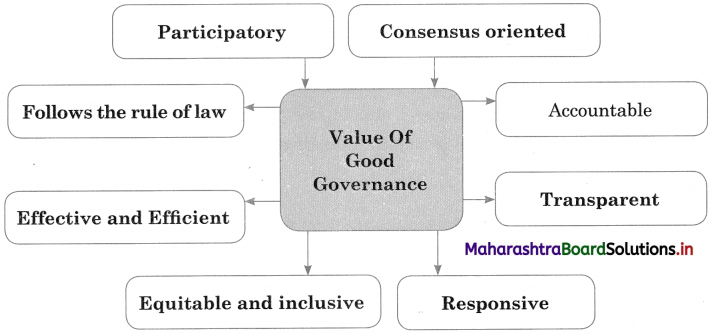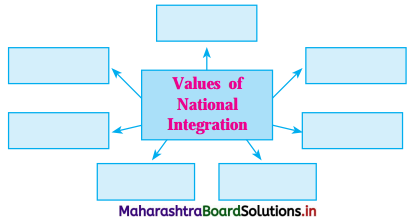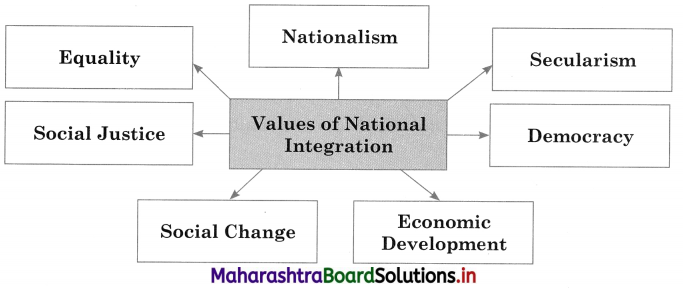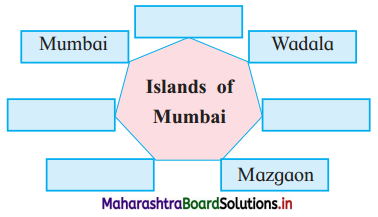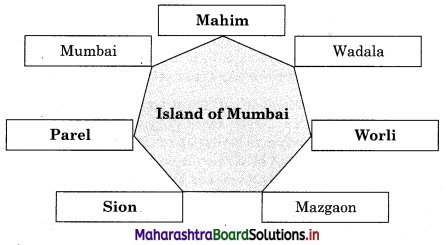Balbharti Maharashtra State Board Class 12 History Solutions Chapter 9 World: Decolonisation Textbook Exercise Questions and Answers.
Maharashtra State Board Class 12 History Solutions Chapter 9 World: Decolonisation
1A. Choose the correct alternative and rewrite the statement.
Question 1.
In the First World War ____________ and Turkey were defeated.
(a) America
(b) France
(c) England
(d) Germany
Answer:
(d) Germany
Question 2.
In 1935 ____________ was separated from India.
(a) Myanmar
(b) Sri Lanka
(c) the Maldives
(d) Iran
Answer:
(a) Myanmar
![]()
Question 3.
In 1947, first conference of ____________ countries was held.
(a) Unity
(b) Asian
(c) Atlantic
(d) Manchester
Answer:
(b) Asian
1B. Find the incorrect pair from group ‘B’ and write the corrected one.
Question 1.
| Group ‘A’ | Group ‘B’ |
| a. Bandung | Bandung conference |
| b. Paris | The first Pan-African Congress in 1919 |
| c. London | The first Conference of ‘African Association’ in 1900 |
| d. Manchester | Asian Unity Conference |
Answer:
Manchester – The 5th Pan-African Congress in 1945
2. Choose the correct reason from those given below and complete the sentence.
Question 1.
During the Second World War, the independence movements in Africa were more intensified ____________
(a) The colonies in Africa threw away the dominance of alien European powers
(b) African leaders were trained in the western education system
(c) During the Second World War the British and the French began to give some rights to the people in their colonies
(d) European countries were involved in the Second World war
Answer:
(c) During the Second World War the British and the; French began to give some rights to the people in their colonies
3. Write short notes.
Question 1.
Bandung Conference.
Answer:
- India called the first conference of Asian countries in 1947 which was attended by the representatives of 25 Asian countries.
- In this conference, the concept of Asian regionalism was shaped. The issues like common problems faced by Asian people, the social, economic, and cultural problems of the Asian countries, and the need for mutual co-operation among Asian countries were discussed in this conference.
- This conference was followed by the first conference of Asian and African countries held in 1955 at Bandung in Indonesia. This is known as the ‘Bandung Conference’.
- In this conference, the problems of Afro-Asian countries were discussed and it was decided to focus on world peace and mutual co-operation.
![]()
Question 2.
Concept of African Unity.
Answer:
- The concept of African unity was first put forward by H.S. Williams. He formed an organization while in London, called as ‘African Association’ (later called as Pan-African Association).
- He organised its first conference in 1900. W.E.B. Du Bois, an American sociologist of African origin was present at this conference.
- In 1919, the second conference of African leaders and thinkers was held in Paris, known as the ‘Pan-African Congress’.
- Thereafter, W.E.B. Du Bois and his associates called a series of Pan-African Congress at various places. This resulted in the idea of Pan-African unity taking deep roots in Africa.
- The 5th Pan-African Congress was held at Manchester in 1945 by people of African origin living in Manchester.
4. Explain the following statements with reasons.
Question 1.
There were three wars fought between the British and Myanmar.
Answer:
- Myanmar is a Southeast Asian country. In 1599 the Portuguese defeated the king of one of the kingdoms in Myanmar.
- However, in 1611 various dynasties ruling in Myanmar got together, defeated the Portuguese, and amalgamated their kingdoms.
- United Myanmar adopted an expansionist policy and conquered Manipur and Assam.
- It means that the British Indian territory was under threat of being invaded, a situation that caused three wars between the British and Myanmar is known as the Anglo-Burmese war.
- The first war in 1826 was won by the British and they took over Assam and Manipur and Arakan.
- British also defeated Myanmar in the second war. At about the same time the French had taken over the regions of ‘Upper Burma’.
- In the third war, the British won this region too, thereby ruling over the entire Myanmar.
- In this way during three Anglo-Burmese wars British annexed the entire Myanmar.
![]()
Question 2.
The end of the Second World War created an environment in which the process of decolonisation gained speed.
Answer:
- The Second World War dealt a serious blow to the colonial powers, depriving them of their former prestige.
- The process of decolonisation accelerated in a short time because of the conflicts among European coloniser countries and the anti-colonial movements in the colonies.
- The European countries could not have reasoned out colonisation and the exploitation of colonies from an intellectual platform.
- The Asian and African continents were filled with a heightened spirit of independence movements.
- The awareness about these movements spread rapidly. Many countries in both continents obtained their freedom.
- In ten years following the end of the Second World War, with successive waves of decolonisation in Asia and Africa, the Third World took its place as a new player in the international arena.
Class 12 History Chapter 9 World: Decolonisation Intext Questions and Answers
Get to know: (Textbook Page No. 72)
Collect more information regarding the ‘Atlantic Charter’ and organise a class discussion on the topic.
Answer:
Introduction: The Atlantic Charter was a pivotal policy statement issued on August 14, 1941, that defined goals for the post-war world. The Atlantic Charter was drafted by British Prime Minister Winston Churchill and U.S. President F.D. Roosevelt at the Atlantic Conference in Newfoundland. All the allies of World War II later confirmed it. The terms of the Atlantic Charter were as follows:
- No territorial expansion and territorial changes were against the wishes of the people.
- All people had a right to self-determination.
- No territorial gains were sought by the U.S. and the U.K.
- Trade and barriers were to be lowered.
- There was to be global economic co-operation and advancement of social welfare.
- The participants would work for a world free of want and fear.
- The participants would work for freedom of the seas.
- There was to be disarmament of aggressor nations and post-war common disarmament. This agreement proved to be one of the first steps towards the formation of the United Nation.
Discuss in the Class (Textbook Page No. 75)
Make a list of the colonies of the British colonies in Asia and Africa with their geographical locations and discuss in the class their independence struggle and the dates of their independence.
Answer:
Introduction: The decolonisation of Asia was the gradual growth of independence movements in Asia, leading ultimately to the retreat of foreign powers and the creation of a number of nation-states in the region. A number of events were catalysts for this shift, most importantly the Second World War.
The freedom struggle of some of the countries like Sri Lanka, Maldives is mentioned in the textbook. The countries of Asia and Africa which got independence from British rule are as follows:
1. British colonies in Asia
Hong Kong:
- Hong Kong is a coastal city and major port in southern China.
- It was returned to the United Kingdom following its war. It was controlled directly by a British governor until the expiry of the 99-year lease of the New Territories which occurred in 1997. From that date, the territories were called as a Special Administrative Region of the People’s Republic of China.
![]()
2. Singapore:
- Singapore officially known as the Republic of Singapore is a sovereign island city-state in maritime Southeast Asia.
- In 1819, Sir Thomas Raffles negotiated a treaty whereby King Johor allowed the British to locate a trading port on the island, leading to the establishment of the British crown colony of Singapore.
- After the end of World War II British granted self-government culminating in Singapore’s merger with Malaysia.
- On 9th August 1965, Singapore separated from Malaysia to become an independent and sovereign state.
3. India:
- India is situated in South East Asia surrounded by the Bay of Bengal on the southeast, the Arabian Sea on the west, and the Indian Ocean on the south.
- India got independence from British rule on 15th August 1947. Indian National Movement under the leadership of Mahatma Gandhi played an important role in the freedom of the country.
4. Pakistan:
- Pakistan is in Asia, the neighbouring country of India.
- As the United Kingdom agreed to the partitioning of India in 1947, the modern state of Pakistan was established on 14th August 1947.
5. Cyprus:
- Cyprus is an island in the Eastern Basin of the Mediterranean Sea in Western Asia.
- In 1914 it was annexed by U.K Between 1945 and 1959 EOKA was created that fought a campaign for the end of British rule in Cyprus.
- An independent ‘The Republic of Cyprus’ was created in 1960.
6. British colonies in Africa:
- On 31st May 1910, Britain gave South Africa nominal independence.
- This union was a dominion that included the former colonies of the Cape and Natal.
- This union only became fully sovereign in 1931 when all powers Britain had over the country were abolished.
7. Egypt:
- Egypt has coastlines on the Mediterranean Sea, the River Nile, and the Red Sea.
- The Egyptian Revolution of 1919 was a countrywide revolution against the British occupation of Egypt.
- The revolution led to Great Britain’s later recognition of Egyptian independence in 1922.
8. Nigeria:
- Lagos was invaded by British forces in 1851 and annexed in 1865.
- It became a British protectorate in 1901 while her colonization lasted until 1960 when an independence movement succeeded in gaining independence and Nigeria became an independent republic in 1979.
![]()
9. Ghana:
Got independence on 6 March 1957.
10. Kenya:
Became independent on 12 December 1963.
Project (Textbook Page No. 76)
Collect information with the help of the internet regarding French colonies in Asia and Africa.
Answer:
In the 19th century starting with the conquest of Algiers in 1830 France began to establish a new empire in Africa and Southeast Asia. The following is a list of all countries that were part of the French colonial empires in the last 500 years.
- French Indochinese Union (1887 – 1954)
- Laos (protectorate) (1893 – 1953)
- Cambodia (protectorate) (1863 – 1953)
- Vietnam
- India and Sri Lanka: French establishment of India composed of Puducherry (1765 – 1954), Karikal (1725 – 1954), Chandranagar (1673 – 1952), Yanam (1673 – 1952)
- Taiwan (1884 – 1885)
- Basilan (1845)
- Lebanon (1920 – 1946)
- Syria (1920 – 1946)
- China: The territory of Kouang-Tcheou-Wan (1898 – 1945), The province of Yunan, Hainan, Guangdong, Guangxi and Shamian island (1859 – 1949)
